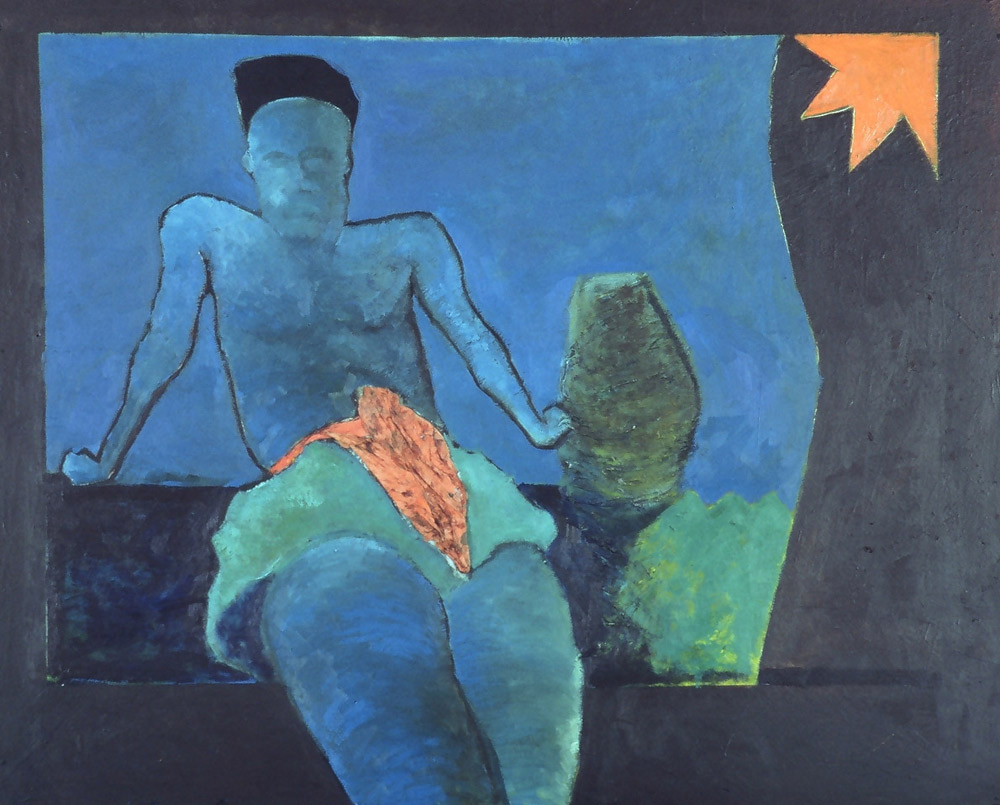ARTISTS Mark Adams, Thomas Andrew, Tom Burnett, Tai Carpentier, Mrs Pareu Ebera, Fatu Feu’u, Tony Fomison, Matarena George, Shirley Grace, Pani Hemaloto, Ioane Ioane, Ajo Jakupa, Sale Jessop, Glen Jowitt, Mathias Kauage, Mrs Koi Puia, Lily Laita, Mark Lander, Robert Leger, Iosefa Leo, Barry Lett, Mrs Marama Ereutea Lineen, Tai’i Ngaata, Terry Nicholson, Johnny Peninsula, John Pule, Te Aukatai Richard, Ian Scott, Roger Smith, Mrs Tekura Tauma’a, Mrs Merapi Teura, Teuane Tibbo, Filipe Tohi, Michael Tuffery, Jim Vivieaere, Melvyn Webb, Robin White CURATOR Rangihiroa Panoho ORGANISER Sarjeant Gallery, Whanganui OTHER VENUES Sarjeant Gallery, 15 December 1990–3 March 1991; Auckland City Art Gallery SPONSOR Te Waka Toi
Te Moemoeā no Iotefa is a groundbreaking show. It traces the development of art forms of the Pacific diaspora, from pre-colonial times to the post-colonial present. It's starting point is a Tahitian tivaevae featuring the Genesis story of the 'Dream of Joseph' (Te Moemoeā no Iotefa).
In the catalogue, curator Rangihiroa Panoho describes a 'a web of intricate connections', as 'common information dispersed over vast distances ... information required to replant the culture'. Landings of Pacific communities across the North Island are described as a vibrant mishmash of traditions and adaptations: 'Samoan cricket in a Grey Lynn park in summer. Heavy body tattoos, lavalavas and people, always lots of people. Minutes away through cracks in a fence Cook Island tivaevae can be seen drying in a local backyard. A garden of designs and colours feature on these quilts—lying flat under the shade of some apple trees. There are new designs—carnation, chrysanthemum, pansy, rose, orchid, grape, and arum lily—the local equivalent of taro, breadfruit, and frangipani.' These vignettes encapsulate the sensibility of the show.
Contemporary Pacific artists—including Ioane Ioane, Fatu Feu’u, John Pule, Michel Tuffery, and Jim Vivieaere—form the backbone of the show. They work in traditional and non-traditional mediums. Feu’u translates Pacific siapa patterns into oil on canvas. Ioane's Eddie (1985) uses bright colour and a modernist style, but is painted on barkcloth rather than canvas. Vivieaere, who was born in New Zealand and raised by Europeans, says his art reflects his recent interactions with his roots and belatedly meeting his father. ‘The sound of palm trees, the strata of blues in the reef, gardenia scent, the drums and dance, and then I met my father. I guess it was all those initial sensations and resonances that I began to involve in my work.’ John Pule's Born in Paradise (c.1990) and Liku (1990) recall Colin McCahon, with their stark, imposing, but Niuean, text. Beside them, Panoho hangs decorated barkcloths that also incorporate text, to highlight an equally applicable influence. Pule’s reasoning is ‘It’s aimed at English people but not in an angry sense—so the English person can stand there and look at it and not understand it at all.’ These contemporary practices refuse any essentialist categorisation—as primitive, imitative, or acculturated to the palagi way of life.
The show includes traditional tapa, masi, ngatu, and weavings alongside more contemporary urban forms, such as lei fashioned from plastic. A 'Pacific Island Bedroom/Sitting Room' reproduces the modern domestic environment that taonga like tivaevae occupy. It incorporates a TV, loungers, church hats, and an adorned religious portrait. (This installation changes in other venues, as local Pacific communities are invited to incorporate their personal treasures into the display.) Work by palagi artists—including Tony Fomison, Barry Lett and Glenn Jowitt—is deliberately juxtaposed against works of Pacific art, highlighting the exchange between the two groups.
The catalogue includes short interviews with ten artists, exploring their work and their relationships to their island roots and the New Zealand they call home. As Panoho writes in his catalogue essay, ‘The umbilical cord with the islands has not been severed. The traditions are still there—the visual vocab has simply been extended.’ In her interview, Lily Aitu Laita says: ‘I think it’s hard for a lot of Pacific Islanders to understand art, in the European sense, because it’s taken aside and kept separate. Art isn’t a separate thing in the culture. It’s one and the same. It’s everything you do.’
Local artists who specialise in embroidery and weaving—employing traditional methods with modern materials—work in the Gallery during the show. Wednesday-evening performances and discussions involve cultural organisations and youth groups. A Dominion Post review says: ‘People who like to keep art in neat pigeonholes labelled “primitive” or “neo-expressionst” and suchlike will probably find Te Moemoea No Iotefa defeats them.’
In the 2012 book, Art of Oceania Pacific, art historian Peter Brunt says, 'The first exhibition to focus on contemporary Pacific art in a civic gallery in New Zealand was Te Moemoeā no Iotefa ... The exhibition thematised the presence of Pacific culture in New Zealand society, introduced community-based arts like tivaevae into the contemporary gallery, and canvassed the work of migrant artists like Fatu Feu'u, Johnny Penisula, Michel Tuffery, and others, only then beginning to garner serious public attention. But it was the title that was the most prescient about its own historical significance. The title was borrowed from the title of a tivaevae it showed, and refers to the biblical story of Joseph sold into slavery in Egypt by his brothers, eventually to rise to a position of power in the Pharoah's court. Joseph's dream turns out to be an allegory of the moment of recognition when, as an exile, he reveals himself to his brothers as the important person he has become. The ambiguity of the allegory lies in the question of whether recognition in Egypt or escape from Egypt (if we can pardon the Orientalism) is the preferable goal.'


























































